|
This Section: The well-known Monsignor James
Francis Kelley's words about his post-war friend, Irene O'Crowley Craigmile, who he in-time disclosed was formerly known
as, Amelia Earhart.
Above is Monsignor James Francis Kelley, in 1946, next to a bronze
bust of his likeness commissioned by the Smithsonian Institution. Right after World War Two ended in 1945, according to the
highly regarded Monsignor himself, he helped to receive an "ill and emotionally compromised" Amelia Earhart
back in the United States. He also mentioned that he oversaw her recovery process--and that by 1946, with
his enlisted help and guidance, she was going by her new name of 'Irene O'Crowley Craigmile' while employed at a bank on New
York's Long Island.
By far, Monsignor James Francis Kelley had
the most supportive relationship with the post-war Irene O'Crowley Craigmile, AKA the former Amelia Earhart.
Before his passing took place in 1996, from the late 1970s on he had confided to close acquaintances of his that his long
time friend, Irene, was actually the former Amelia Earhart, who he had helped establish a new, non-public life existence
for after World War Two.
|
The above mention came from a 1982 New
Jersey Tribune article. Publicly, Msgr. Kelley was reluctant to share what he knew about is later life 'close' friend, the
post-World War Two Mrs. Irene O'Crowley Craigmile-Bolam. In private, he did confide to
select people that she used to be known as, Amelia Earhart.
|
The post-World
War Two, Mrs. Irene O'Crowley Craigmile-Bolam, FKA Amelia Earhart, dining
with Msgr. James Francis Kelley, 1978.
|
~~~ About "Truth" "Truth
is not a mystery -- its greatest secrets are yours to know through simple honesty and surrender to what that honesty reveals."
John de Ruiter
~~~
Below: Monsignor James Francis Kelley. He merely told the
truth about his later life good friend, Mrs. Irene O'Crowley Craigmile-Bolam.
|
|
|
| Monsignor James Francis Kelley & post-war Irene, FKA Amelia |
| |
|
|
| Monsignor Kelley's beautiful St. Croix, US Virgin Islands home. |
| |
|
|
| Kelley's beautiful Rumson, NJ home. The post-war Irene was a familiar guest at both homes |
|
NOTE: In 1991, retired Air Force Major Joseph A. Gervais and retired Air Force Colonel Rollin C. Reineck
held a press conference in Hawaii to provide a recent update pertaining to their ongoing investigation of Amelia Earhart’s
1937 disappearance. Their statement foremost reconfirmed their belief that Amelia had 'quietly survived' World War Two. Colonel
Reineck soon after received a letter from a Mrs. Helen Barber, of Wayne, Pennsylvania, who had read about their press conference
in the news. Mrs. Barber described something her seasonal neighbor, Monsignor James Francis Kelley, had shared with she and
her husband years earlier. She also referred Colonel Reineck to another couple she knew, Mr. and Mrs. Donald DeKoster, of
Detroit Michigan, who she mentioned would additionally verify the information Father Kelley had described to she and her husband.
Both the Barbers and the DeKosters were fairly affluent and owned winter homes in the Virgin Islands on St. Croix, near to
Monsignor Kelley's home there. The Dekosters lived next door to Father Kelley there, and would sometimes drive him places.
Donald Dekoster mentioned he and the monsignor were "very close". The following was excerpted from the letter sent to Colonel Reineck by Mrs. Helen
Barber after the press conference: “Dear Colonel Reineck, My husband and I read
about your news conference in Hawaii. We are impressed by the integrity of your investigation into the Earhart matter and
we simply had to contact you with a related experience we have kept to ourselves for many years. We have a home in the Virgin
Islands where we spend winters and one of our neighbors down there is Monsignor James Francis Kelley. Monsignor Kelley owns
a beautiful home on top of a hill on the island of St. Croix where our winter home is also located. In 1981, during a luncheon
with him, he related to us and another couple, the Dekosters, how he was commissioned at the end of the war to help bring
Amelia Earhart back from Japan. He said he was chosen to serve as her psychiatric priest. He also told me something about
missing documents he had to get that she needed in order to help with her identity change. The Monsignor told us that he received
her as she was being subjected to an identity change. He told us that she stayed with him at his New Jersey home and I believe
sometimes his St. Croix winter home while he helped with her emotional, spiritual, and psychiatric needs.” Above passage reprinted from a 1991 letter that Helen Barber sent to Colonel Rollin C. Reineck,
USAF (Retired). Colonel Reineck also tape-recorded different phone conversations he had with Mrs. Barber, Mr. Donald Dekoster,
Monsignor Kelley, and the Monsignor's sister, Gertrude Kelley Hession, who in the 1970s' occasionally travelled with the former
Amelia Earhart. Both the Barber's and the DeKoster's stressed that they did not doubt the veracity of what Monsignor Kelley
had confided to them about Amelia Earhart's post-disappearance survival and her name change to 'Irene.'
|
EXCERPT FROM
A TAPE RECORDED CONVERSATION BETWEEN MONSIGNOR JAMES FRANCIS KELLEY AND USAF COLONEL ROLLIN C. REINECK (Ret.), SEPTEMBER,
17 1991:
REINECK: I understand you were President of Seton Hall.
KELLEY: Yes, I was President of Seton Hall for many years.
REINECK: If I were to come and talk to you would I
be able to see some of the things you have of Amelia Earhart's?
KELLEY: Absolutely. Surely.
REINECK: We believe Jackie Cochran was sent to Japan to help bring Amelia
home. Are you aware of that?
KELLEY: Yes, I was involved with that.
REINECK: Could you give me your address?
KELLEY: [Msgr. Kelley provides his Rumson, New Jersey address.]
REINECK: I'm going to try to come back there and talk
to you.
KELLEY:
All Right.
REINECK:
Thank you for your help.
KELLEY: What city are you in?
REINECK: Honolulu, Hawaii
KELLEY: Oh my gosh, and you're going to come over here?
REINECK: Yes sir. If you have things of hers [Earhart's]
I would like to see them. Are you aware that she was Irene Bolam?
KELLEY: What?
REINECK: Amelia Earhart was Irene (O'Crowley Craigmile) Bolam?
KELLEY: That's right, yes.
~~~
Monsignor James Francis Kelley served as President of Seton Hall College from 1936 to
1949. He knew Charles Lindbergh, Amelia Earhart, and a slew of other important figures and celebrities.
|
| With New Jersey Governor, Brenden Byrne... |
|
|
| ...Monsignor Kelley being awarded a Doctorate of Law Degree |
|
|
| Msgr. Kelley with friends, Jackie Gleason and Ted Hussing |
|
|
|
| Monsignor Kelley with his friend, Ed Sullivan. |
| Monsignor Kelley & Pope Paul VI at the Vatican, |
|
|
| during a 1960s visit. Janey Blaylock is also in the photo. |
|
| Kelley with Jack Warner of Warner Bros. Pictures. |
|
|
| Msgr. Kelley was also well acquainted with Spencer Tracy and Clark Gable. |
|
|
| Kelley with Betty Ford and Marge Montana |
|
| Monsignor Kelley with N.J. Gov. Byrne and his wife |
|
|
| ...and baseball Commissioner Bowie Kuhn and his wife, and Sandy Palmer. |
From the late 1970s into the 1990s, Monsignor James
Francis Kelley (1902-1996), a past president of Seton Hall College in New Jersey, confided to select individuals that his
later life good friend, Mrs. Irene O'Crowley Craigmile-Bolam, had previously been known as, Amelia Earhart. In 1987,
he described to Rockville, Illinois TV reporter, Merrill Dean Magley, that "after all she had been through [during the
World War Two years] she didn't want to be the famous Amelia Earhart anymore."
Skeptics countered that Msgr. Kelley must have been 'crazy' in his old age to have said
what he did. A few also described him as a "braggart" and a "bull shooter." Even Father Kelley's nephew,
Adrian 'Red' McBride, found it hard to believe his uncle's words about his later life friend, Irene. In a 1991 tape recorded conversation that Monsignor Kelley had with Colonel Rollin C.
Reineck, USAF (Ret.), the Monsignor was calm and lucid when he mentioned that his later-life friend, Irene, used to be known
as "Amelia Earhart." Other individuals he said the same thing to were certain he was telling the truth. (See one
of their recollections below the following transcript.) The forensic analysis did not commence until after Monsignor Kelley
died in 1996, and the results left no-doubt that Father Kelley had told the truth about Amelia Earhart having changed her
name to 'Irene' at some point, during the late World War Two years, and how he had been integral to the process of it.
"All truth passes through three stages.
First, it is ridiculed. Second, it is violently opposed. Third, it is accepted as being self-evident." Arthur Schopenhauer ~~~
"Think
different," indeed. The above right photo displays the post-war only Irene O'Crowley Craigmile-Bolam combined with her
former Amelia Earhart self. The 'Irene' photo was taken in Dubrovnik, Yugoslavia in 1976. Partially in view seated to Irene's
right is Gertrude Kelley Hession, the sister of Monsignor James Francis Kelley. As mentioned, during
the last decade of his life, Monsignor Kelley, admitted to a few close friends of his--as well as to news reporter, Merrill
Dean Magley, and to Amelia Earhart historian, Colonel Rollin C. Reineck, that his later life friend, Irene, actually did used
to be known as Amelia Earhart. He was scoffed at by those who felt it was impossible for Amelia Earhart to have survived
after she went missing in 1937. A few individuals, including his own nephew, suggested 'old age senility' and a 'need for
attention' caused him to outright fabricate what he claimed to know about Amelia's post-loss survival. Contrary to their rebuttals,
Monsignor Kelley was well known among catholic-faith celebrities for his impeccable reputation. He had served as a president
of Seton Hall College for many years before it became a University in the 1950s, and the close friends he confided in about
his later life friend, 'Amelia' (that's how Kelley referred to her among them) stood by his virtuous nature. He was described
as, 'quite lucid' when he told them about his "assignment" to receive Amelia back in the United States, and his
having been, "instrumental in the process" of her name change to Irene. Again, the first
study to deeply compare Amelia to Irene did not commence until after Monisgnor Kelley died, and its results made it easy to
realize he did not fabricate what he professed to know about Amelia's later life existence as, 'Irene.'
The post-World War Two only Irene O'Crowley Craigmile
was not the original Irene O'Crowley Craigmile. Since 1970, however, when she was correctly implicated to have been
the former Amelia Earhart, her own denials and other obfuscations about her past left most people believing she wasn't the
former Amelia Earhart. Amelia's family and the original Irene's family dismissed it out of hand, and the Smithsonian Institution
played it down enough
to where people felt further suspicion toward who she really was, or used to be, was unnecessary. In the meantime, the U.S. federal government offered no opinion about it.
| |
|
Above photo and caption appeared in a November 2003 edition of the L.A. Times.
|
The former Amelia Earhart (above) was world famous for nine years
in the United States, from 1928 to 1937. After she was declared missing in 1937, she continued to quietly live-on and in time
accepted an option to change her name. Above are images showing the way she appeared in a formal portrait sitting to honor
her true eightieth birthday of July 24th, 1977. By now, given all that has been learned and revealed about the post-war only
Irene, anyone who advances that the person in the two photos above was the original Irene O'Crowley Craigmile, demonstrates
a limited scope of knowledge when it comes to the subject of her full life story.
|
Amelia
|
Post-War Irene & Amelia digitally combined
|
After Digital Face Recognition arrived it acheived a positive match between Amelia and the post-war Irene
|
Amelia and Amelia as Irene in 1964
|
|
Amelia, age 26, a self-portrait photo
taken into a mirror
four years before she became famous in 1928
|
|
|
| Post-War Amelia and Irene digitally combined. |
|
|
Amelia Earhart, age 39 in 1937. She was
declared 'missing' three weeks shy of her 40th birthday.
|
Again
above, Digital Face Recognition matched Amelia Earhart's 1937 image (left) to a 1965 photo (below)
of the post-World War Two only, 'Irene Craigmile.' The 1965 photo appeared in a controversial book about Amelia Earhart that
was quickly vilified by the former Amelia Earhart herself before it was withdrawn by its publisher, McGraw-Hill.
|
|
|
Amelia and Amelia as Irene
|
Amelia, age 31
Amelia as Irene, 1977
|
|
As initiated by the Study results, Digital Face Recognition
went on to confirm face template congruences between all 1930s Amelia Earhart photos that were compared to photos of
the post-World War Two only, Mrs. Irene Craigmile (Bolam.) The 'post-war only' Irene photo used in the above comparison was
taken in the mid-1970s. Note her familiar wings, pearls, and broad white collar.
|
|
|
Amelia Earhart
|
With Amelia's and the post-war only Irene's head-to-toe
physical beings and character traits, The Swindell Study realized a complete match.
|
The post-World War Two only,
Mrs. Irene Craigmile Bolam
|
|
Above, the former Amelia Earhart living as 'Irene' in 1976.
|
"I had
a career as a pilot once, Major, but I gave all that up years ago." 1965 quote from the post-World
War Two Mrs. Irene Craigmile (Bolam), FKA 'Amelia Earhart' as spoken to Major Joseph
A. Gervais, USAF (Ret.) Above photo taken in Jamaica in 1976. (Courtesy
of the Diana Dawes collection.)
|
|
|
Amelia Earhart
|
Amelia and Amelia as Irene, 1970
|
|
|
Amelia as Irene at her 1970 press conference; She had no other choice but to deny her past.
|
Monsignor James Francis Kelley President of Seton Hall College from 1936
to 1949; held Doctorates in Philosophy and Psychology
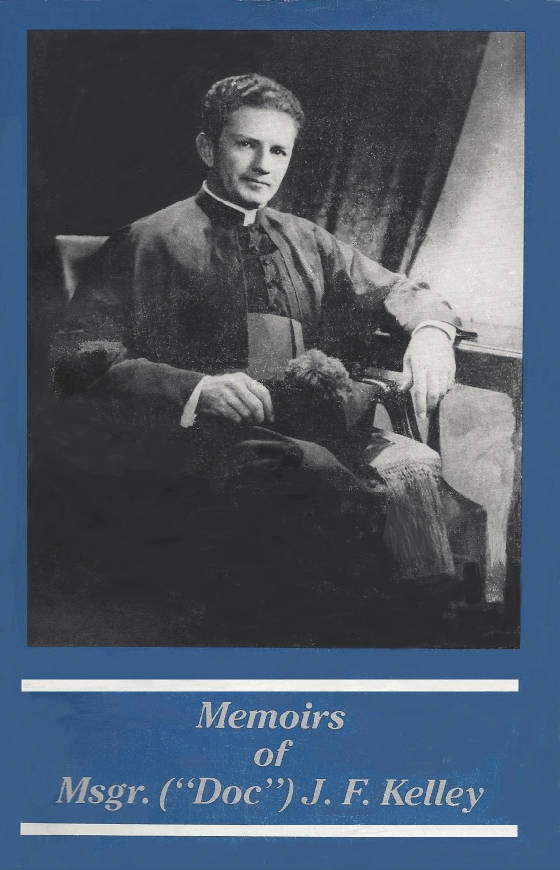
|
| Cover of Monsignor James Francis Kelley's autobiograpphy |
Monsignor James Francis Kelley [1902-1996] was a long
time President of Seton Hall College in New Jersey. He was given much credit for turning the school into a University in 1949.
Father Kelley had many famous friends in government, politics, and show business, and he was a highly regarded figure in the
Catholic Church, to include his having hosted Pope Paul VI as an overnight house guest in 1965, when the Pontiff became the
first ever to visit the United States. According to his New York Times obituary, he also helped teach English to Pope Pius
XII while he was being educated overseas. In the 1970s, Monsignor Kelley first began breaking his silence to a few people
who were close to him, about his friend, Mrs. Irene Bolam [the Gervais-Irene] having been previously known
as 'Amelia Earhart.' He disclosed that it was true Amelia had survived her disappearance under Japan's stewardship, and she
had quietly returned to the U.S. after the war. Opting for future privacy, he acknowledged Amelia assumed a different name
for herself as well, one that he helped secure for her future use, that of 'Irene Craigmile.' To his good friends, Donald DeKoster and Helen Barber, Father Kelley described how
he was the person who had been 'assigned to receive Amelia' when she returned to the U.S., that he had 'helped with her physical
and emotional rehabilitation,' and that he had been 'instrumental with her new-identity transformation.' As seen in the news article clip to the left below, after the former Amelia
Earhart died in 1982 known as Irene Bolam, Monsignor Kelley was still shying away from allowing the truth about her past to
become public information:
In his 1987 published autobiography, Monsignor
James Francis Kelley included the following passage in his "My Reasons For Writing This Book" chapter that begins
on page 10: "My
reason for not wanting anyone else to do my story was that I knew many of my files contained some very personal and intimate
stories about many people, prominent nationally and internationally. Some of them were now dead and I felt that to allow someone
else to have access to these documents could result in the publication of data about deceased people who could not defend
themselves." ~~~ In 1991 Monsignor Kelley described to USAF Colonel Rollin
C. Reineck that he had written a chapter about his experience with Amelia Earhart for his book that was ommitted from the
final edition. Colonel Reineck interviewed him at length and actually recorded one of their conversations. Below is a transcripted
excerpt from his 1991 taped interview with Father Kelley. Colonel Reineck had tracked down the elderly Monsignor after he
spoke with and learned the information he had disclosed over a decade earlier to Helen Barber and Donald DeKoster. Father
Kelley plainly described how he had known Amelia and still had some items that she gave him in his Rumson home. Repeating
the end of the conversation from above, the following passage can still be heard today in their taped conversation: Col. Reineck: If you have things of hers [Earhart's] I would like to see
them. Are you aware that she was Irene Bolam? Msgr. Kelley: What? Col.
Reineck: Amelia Earhart was Irene Bolam? Msgr. Kelley: That's right, yes.
| Dubrovnik, Yugoslavia 1976 |
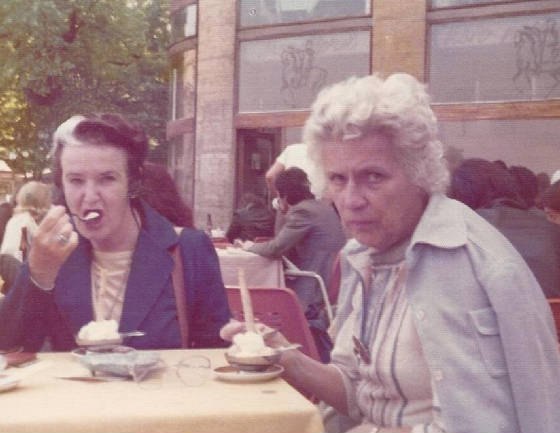
|
| Monsignor Kelley's sister, Gertrude Kelley Hession (left) with the Gervais-Irene Bolam |
| Gervais-Irene [FKA 'Earhart'] in Yugoslavia-1976 |
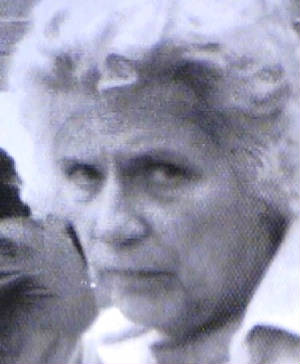
|
|
| ...superimposed with classic Amelia photo... |

|
|
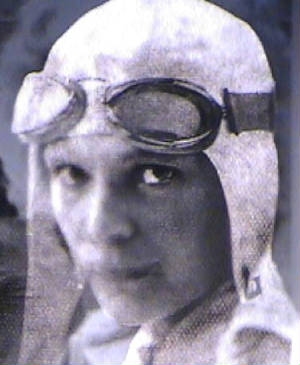
|
| ...displays the congruence. |
|
"Amelia Earhart survived
and she eventually returned to the United States. There's no doubt about it anymore." USAF Colonel Rollin C. Reineck
(Ret.), who met and spoke with Monsignor Kelley, from an interview with the National Geographic Channel, 2006.
Monsignor Kelley Was Awarded For
His War Time Servitude Note the 'Henry P. Morgenthau Jr.' and 'J. Edgar Hoover' References
Beyond his Seton Hall accomplishments and the 1946 bust statue of his likeness commissioned
by the Smithsonian Institution, Monsignor Kelley received many awards and commendations. One 'citation
and medal' he received
on July 11,
1941 was awarded to him by none other than U.S. Secretary of the Treasury, Henry P. Morgenthau Jr. As previously mentioned,
in 1938, Morgenthau, who oversaw FDR's Secret Service division, had refused to make public information withheld by the White
House pertaining to Amelia Earhart's 1937 disappearance. It is no coincidence the stated reason for the 1941 award given
to Kelley by Morgenthau was: "For three years of Patriotic Service with integrity and diligence for the Treasury Department of the United States of America,"
where simple math shows three years prior to 1941 was 1938, the same year Henry P. Morgenthau, Jr. refused
to release the White House final report on the disappearance of Amelia Earhart.
Two other post-WWII awards the Monsignor received were relevant as well: "June 18, 1946 - received citation from the War Department through Commanding
General of the U.S. Army Air Force, Carl Spatz [who Amelia's good pilot friend, Jackie Cochran spent time with on Guam
just prior to her becoming the first American woman to enter Japan after VJ Day] and Secretary of the War, Robert P. Patterson,"
and a "November 20, 1946 citation from J. Edgar Hoover for
assistance rendered during the war years to the Internal Security of the Nation through the Federal
Bureau of Investigation of the United States Department of Justice." It's
interesting to note here, how the Arthur Gibson classified State Department file leaked in 1972 labeled, "Earhart,
Amelia: Special War Problems" bore the date of Sept. 7, 1946.... a date between the two dates listed
above; June 18, 1946 and November 20, 1946. 1946 also marked the first year the former Amelia Earhart publicly emerged in
the United States reidentified as, 'Irene Craigmile.'
| Monsignor Kelley shown in a family picture... |
|
|
| ...his sister, Gertrude in white on his left. |
| Msgr. Kelley's sister Gertrude & the Gervais-Irene |
|
|
| Dubrovnik, Yugoslavia 1976. |
| 1944, Monsignor Kelley awards F.B.I. Director.... |
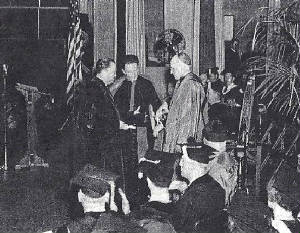
|
| ...J. Edgar Hoover Seton Hall's LLD with Archbishop Thomas Walsh. |
"J. Edgar Hoover's fingerprints were all over Amelia
Earhart's continued survival and her later name-change to Irene." Joe Gervais
Note: From 1970 on, to include
after the Gervais-Irene died in July of 1982, people continued to question her past. Directly below,
reprinted from above is Msgr. Kelley's telling quote that left the curious teetering on the brink of accepting historical
reality:
| Msgr. Kelley's reporter refusal... |
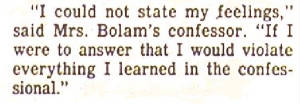
|
| ...he later admitted his friend (the 'Gervais-Irene') used to be known as Amelia Earhart |
|
| Kelley's sister Gertrude & the Gervais-Irene |
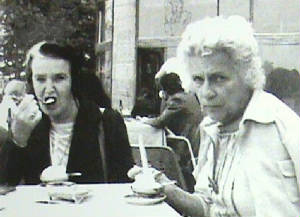
|
| Dubrovnik, Yugoslavia 1976. |
The truthful
nature of Monsignor Kelley's later admission that confirmed his long time friend, the Gervais-Irene
was previously known as Amelia Earhart, became clearer after the Forensic Analysis discovered the Gervais-Irene appeared
nowhere identified as 'Irene' prior to the 1940s...
| The Gervais-Irene |
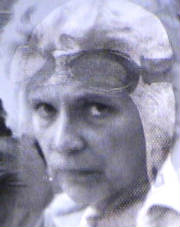
|
| Superimposed with Amelia Earhart photo begins... |
|
| Monsignor James Francis Kelley, 1946... |
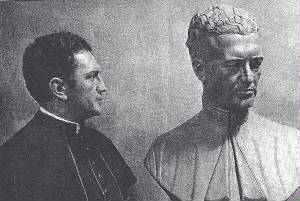
|
| ...with the Smithsonian Institution's commissioned bronz bust of his likeness. |
...then
after it was forensically ascertained that three different women had been attributed to the same 'Irene' identity,
with the Gervais-Irene, who Kelley knew well, matching Amelia head-to-toe
and character trait wise, Monsignor Kelley's past admission was naturally verified.
| The Gervais-Irene... |
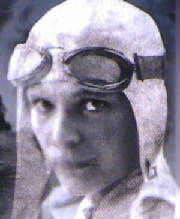
|
| ...superimposed with Amelia Earhart. |
|
Monsignor Kelley's 1996
New York Times Obituary: Msgr. James Kelley, 94, a President of Seton Hall
By DAVID STOUT
Published: September 14, 1996 Msgr. James F. Kelley, who became president of Seton Hall College at age
33 and guided its transformation from a tiny liberal arts college to a large university, died on Tuesday at the Medical Center
of Ocean County in Brick, N.J. He was 94.
Monsignor Kelley was pastor of Our Lady of Mount Carmel Church in Ridgewood, N.J., after leaving Seton Hall.
He served the Ridgewood parish until retiring 20 years ago and moving to Rumson. He was named president of Seton Hall on July 9, 1936, becoming the youngest
college president in the United States. Eighteen days later, he turned 34. The college in South Orange, N.J., then had two departments, liberals
arts and sciences, and about 300 students. When he completed his presidency in 1949, after opening the doors to thousands
of returning veterans, it had 11 undergraduate departments, 2 graduate divisions and more than 13,000 students. It now has
about 9,500 students. ''He
turned it into a university,'' Msgr. Walter Jarvis, who is 92 and taught at Seton Hall for 29 years, said yesterday, ''and
his door was always open.'' 
 Seton Hall gained university status in 1950, a year after Monsignor Kelley stepped down. Seton Hall gained university status in 1950, a year after Monsignor Kelley stepped down.
''Monsignor Kelley has left a valuable legacy to generations of Seton
Hall University students,'' said Msgr. Robert Sheeran, Seton Hall's current president. In the first year of his presidency, Father Kelley ordered the creation
of a division for female students, offering classes in late afternoons and evenings and on weekends. Before long, women were
admitted as full-time students. While
Monsignor Kelley was president, Seton Hall's Walsh Gymnasium was built and the campus radio station, WSOU, was founded. Born in Kearny, N.J., Monsignor Kelley attended
Seton Hall Preparatory School and graduated from the college in 1924. He studied at the American College in Belgium from 1924
until 1928, when he was ordained in Louvain, Belgium. He received a doctorate in philosophy from the University of Louvain
in 1935. On April 20, 1941, he
was named a monsignor by Pope Pius XII, whom he had taught English in Belgium. From 1947 to 1949, he was president of the New Jersey Association of Colleges
and Universities. From 1951 to 1968, he was chaplain for the Ridgewood police and fire departments and the Ridgewood Knights
of Columbus. From
1960 to 1968, Monsignor Kelley was a member of the Ridgewood Juvenile Delinquency Committee. He was vice president of the
Bergen County Narcotics and Drug Abuse Council from 1966 to 1967 and president from 1967 to 1968. He was also president of
the Association of Bergen County Priests from 1966 to 1968.
NASA
Astronaut, Wally Schirra Discusses Earhart
From the 1970s on, a variety of accounts surfaced describing
Amelia Earhart's post-WWII continued existence in the U.S. under an assumed
identity. One of them came from NASA Astronaut,
Wally Schirra.
| Below: Astornaut Wally Schirra |

|
| He told reporter, Dean Magley he 'met' the 'former' Amelia Earhart at NASA in the 1970s. |
In 1988, Astronaut Wally Schirra described
to Rockville, Illinois TV news reporter, Dean Magley, that he had met the woman previously known as Amelia Earhart at NASA's cape Kennedy in the 1970s. Dean
Magley actually filmed a brief interview with Wally Schirra, where the famous astronaut mentioned "reliable people"
had disclosed such a truth to him. The now-late Dean Magley had extensively interviewed Monsignor Kelley as well, and as
a result of his separately conducted interviews with both men and other knowledgeable individuals he had engaged about it,
Dean Magley was fully convinced that the Gervais-Irene Bolam had previously been known as 'Amelia Earhart.' Mr. Magley was
equally convinced such a truth was something the public was left unaware of by intention. Below, note the Gervais-Irene's
survived sister in law's 1993 comment about her late sister-in-law having known "astronauts."
| Joe Gervais Research Award event, Las Vegas, 2000 |
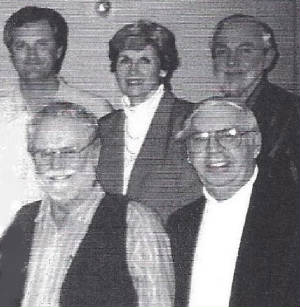
|
| Top row L-R: Tod Swindell, Mrs. & Mr John Bolam, lower, Joe Klaas & Joe Gervais |
The following excerpts came
from a 1993 story written about the Gervais-Irene Bolam by Mrs. John Bolam, her survived sister in-law shown in the above
photo: "She was intelligent, articulate, and had a commanding presence. She knew a lot of
important people including many high-ranking military officers, astronauts
and flyers." "Guy and Irene knew people all around the world, some of which were well known
figures in high places." "She appeared to be completely familiar with any subject we might bring
up about flying in the old days, such as types of planes, instruments, early airports, etcetera." "After
Guy died, she still continued to manage the Radio Luxembourg accounts while trekking around the world."
"She
thoroughly enjoyed life, people, events, theater, travel, new heights. She was the epitome of a "'Classy Lady.'"
"Irene told us she was a member of the 99s and the Zonta's, but others say her name
does not appear in the records of either organization. Why then would they ask her to speak at their national and international
meetings?" [Note: According to the Woodbridge Tribune, from the late 1940s on as 'Irene
Craigmile,' the Gervais-Irene was listed in the Long Island chapter of ZONTA members, and due to her ability to speak several
languages she had served as ZONTA's 'International Relations Chairman' just as Amelia's close English friend, Nina Brodrick
Price previously had. However, there is no record of Irene Craigmile or Bolam ever having been a member of the 99s.]
[Note:
Colonel Reineck referenced the Gervais-Irene Bolam having been awarded a medal of appreciation by NASA.] [Note:
The Gervais-Irene Bolam took over as corporate President of Radio Luxembourg following Guy's 1970 passing.]
[Note: Monsignor Kelley, one of Robert F. Kennedy's former attorneys, Benedict Ginsburg, Arizona
Senator, Barry Goldwater, and Lady Mary Stewart of Scotland were some of the important friends the Gervais-Irene, FKA 'Earhart'
had in her later-life years, as was Jean MacArthur, the survived widow of Gen. Douglas MacArthur. (See photo and story
below.)]
| A New Columbia University Graduate |
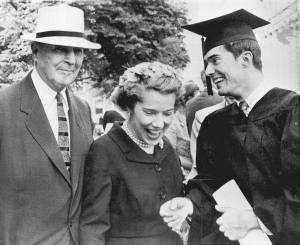
|
| 1961, retired Gen. Douglas MacArthur, his wife, Jean & their son Arthur |
The Gervais-Irene Bolam [FKA 'Earhart'] and Jean
MacArthur were good friends throughout the 1960s and 70s. They would occasionally meet for lunch at the Waldorf Astoria where
Jean resided for many years. [Jean MacArthur died in 2000 at the age of 101.] In the 1960s, Arthur MacArthur IV, the only child of General
Douglas and Jean MacArthur, disappeared. Where did he go? After his famous father died in 1964, Arthur, a graduate of Columbia University with an English degree, changed
his name to 'David Jordan' to conceal his identity. He had been raised in the international spotlight. Born in Manila in 1938,
his toddler image once adorned the cover of Life Magazine. After the end of WWII he and his mother spent much time in Tokyo
while his father oversaw the rebuilding of Japan with Emperor Hirohito. Growing up full time overseas, when he turned thirteen
years old he still had never been to the United States. There is no doubt General MacArthur
was aware of Amelia's continued survival in Japan's custody during the war years, and had helped spirit her non--publicized
return to the United States. It is certain as well, he and his wife, Jean knew Amelia had changed her name to 'Irene' in order
to live out the rest of her years as a non-public person. Their son, Arthur MacArthur IV had a similar yen. Named for his
Civil War hero great grandfather, he had experienced the first 26 years of his life as the heir apparent to his father's legacy.
His parents were never shy about vocalizing their desire for Arthur to embark on a military career. Except Arthur didn't want
that. He'd had enough of 'war.' As a child it was all he knew, plus he always felt a different calling and no longer wished
to be subjugated by his prominent heritage. He had a keen interest in music, literature, arts and the theatre. William Manchester,
author of “American Caesar: Douglas MacArthur" said Arthur was "a fugitive from his father’s relentless
love.” [courtesy ozatwar.com] Today at the age of 78, David Jordan, FKA ''Arthur MacArthur IV" lives in relative
obscurity in Greenwich Village, NY. Here, once again we're reminded of Monsignor Kelley's comment about his friend, the Gervais-Irene
Bolam: "After all she'd been through, she didn't want to be Amelia Earhart anymore." Jackie Cochran's quote about
Amelia is also telling, "God, how the world hounded that woman." There's also a quote by Lou Foudray of the Amelia
Earhart Birthplace Museum, "I believe she came back, but she wanted her privacy." Clearly
as well, with all he'd been through, seeking privacy after his father died, upon deciding he didn't want to be Arthur MacArthur
IV anymore, the recent Columbia graduate thus changed his name to, 'David Jordan.' ~~~
Monsignor Kelley lived near and was acquainted with
the original Irene Craigmile's prominent O'Crowley family of Newark, New Jersey that featured Dr. Clarence Rutherford O'Crowley
and his sister, Attorney Irene Mary Rutherford O'Crowley, the original Irene's Uncle and Aunt. Monsignor Kelley also knew
Charles Lindbergh when Lindbergh lived in Hopewell, New Jersey, and he knew Amelia Earhart as well, who he mentioned had 'changed
her name to Irene in the interest of her future privacy.' One of the Gervais-Irene's close later-life friends, a
Princeton radio show host by the name of Diana Dawes described her own understanding of how the hushed demise of the
original Irene Madeline O'Crowley Craigmile enabled the former Amelia Earhart to acquire her identity during the World War
Two era. No vast conspiracy, it is fairly certain General Douglas MacArthur, J. Edgar Hoover, the O'Crowley family, Amelia,
and Monsignor Kelley had been key figures involved with making such a thing happen. Especially when one considers the timing
of Henry P. Morgenthau's award to Kelley for his "Three Years of Patriotic Service to his Country" and the way it
coincided with Amelia's good ZONTA friend, Attorney Irene Rutherford O'Crowley's 1939 to 1941 handling of the annulment of
her niece's marriage to Al Heller..., thus enabling the name to return from 'Heller' to 'Craigmile.'
~~~
Note: The information displayed here comes from Tod
Swindell's Amelia Earhart Chronicles featuring the first ever, Amelia
Earhart to Irene Bolam Forensic Comparison Analysis.
The chronicles are part of original copyrighted manuscripts and
the forensic analysis Tod Swindell produced. WGAw registrations: "The Lost Electra"
(1996), "A Simple Misunderstanding: Redefining Earhart for the New Century" (1999), "Protecting Earhart"
(2004). Updated U.S. Copyright Office Registrations (2014 & 2017): TXu 1-915-926 (2014); TXu 2-061-539 (2017). ~~~
|

